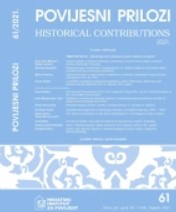Zarazne bolesti, prostorna mobilnost i prevencija u ranome novom vijeku: povijesna iskustva Dalmacije i Slavonije
Early Modern Epidemic Diseases, Space Mobility, and Prevention: Historical Experiences of Dalmatia and Slavonia
Author(s): Dubravka Mlinarić, Sanja LazaninSubject(s): Local History / Microhistory, Government/Political systems, Security and defense, Health and medicine and law, 17th Century, 18th Century
Published by: Hrvatski institut za povijest
Keywords: epidemic diseases; epidemics; mobility; Dalmatia; Slavonia; prevention; quarantine; Sanitary Cordon;
Summary/Abstract: The paper focuses on the interrelation between epidemics and spatial mobility (migration) of people, along with the subsequent development of medical prevention regulations and actions in the Croatian historical territories, primarily during the Early Modern Period. Historical epidemics are viewed from the perspective of social history in terms of their great demographic and economic impacts, since the diseases acted as both causes and results of migrations. The research was based on various archival sources, primarily from the State Archives in Zadar and the Croatian State Archives, correlated with the research of secondary literature (desk-study analysis). While evaluating the different measures of control and medical prevention of diseases, mainly the plague, in Slavonia and Dalmatia, the authors searched for several answers. The focus was on the reactions of two different early modern administrative systems to epidemical hazards. As a consequence of state-implemented measures, the mobility patterns of people and goods were changed. Additionally, the research revealed that the development and upgrading of the overall health system in the Croatian lands was highly influenced by these early anti-epidemic measures. Two differently organised early modern systems of population and economy protection (Habsburg and Venetian) were examined as examples of possible state responses to the spread of epidemic diseases. One was based on secluded quarantine stations in Adriatic harbours, such as lazarettos or quarantine buildings in Dalmatia, while the other was organised as a quarantine medical and custom chain of checkpoints along the Slavonian-Bosnian border (the Sanitary Cordon). Despite the different concepts of these more or less elaborate systems of public health measures in the Venetian and Austrian territories – from informing, legal and sanitary regulations, to the introduction of quarantine for the sick and potentially infected people – both countries sought to prevent the spread of epidemic diseases, while at the same time trying to ensure the flow of people and goods with as little obstruction as possible.
Journal: Povijesni prilozi
- Issue Year: 2021
- Issue No: 61
- Page Range: 9-43
- Page Count: 35
- Language: Croatian

